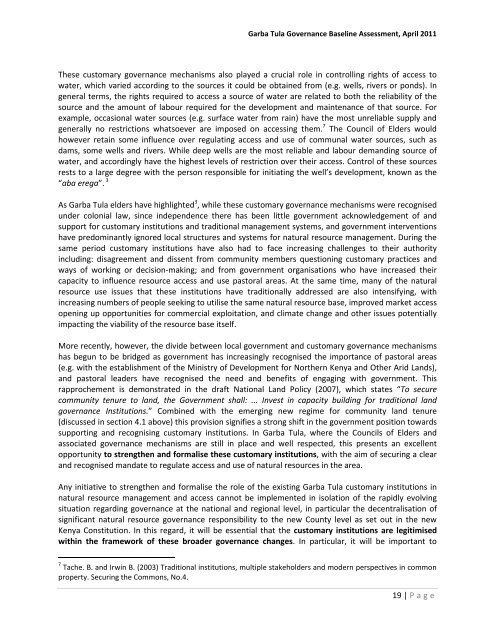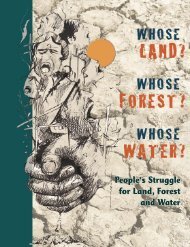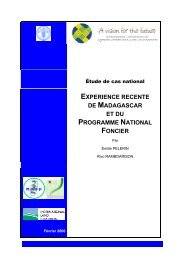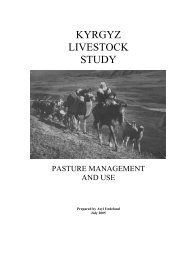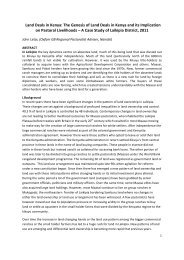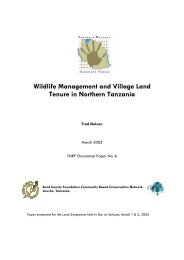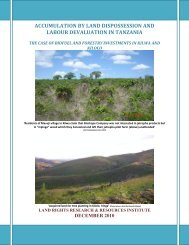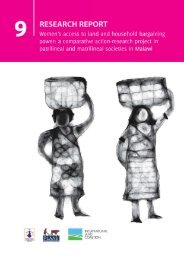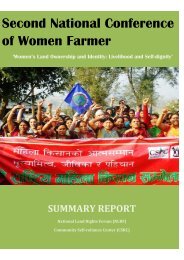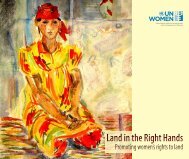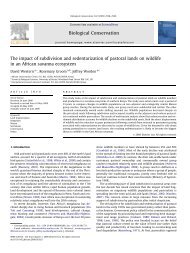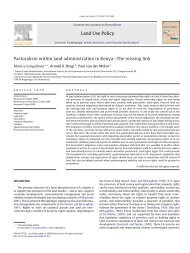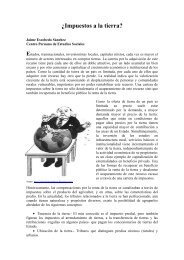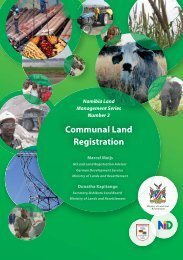Garba Tula Governance Assessment Final Report ... - Land Portal
Garba Tula Governance Assessment Final Report ... - Land Portal
Garba Tula Governance Assessment Final Report ... - Land Portal
Create successful ePaper yourself
Turn your PDF publications into a flip-book with our unique Google optimized e-Paper software.
<strong>Garba</strong> <strong>Tula</strong> <strong>Governance</strong> Baseline <strong>Assessment</strong>, April 2011<br />
These customary governance mechanisms also played a crucial role in controlling rights of access to<br />
water, which varied according to the sources it could be obtained from (e.g. wells, rivers or ponds). In<br />
general terms, the rights required to access a source of water are related to both the reliability of the<br />
source and the amount of labour required for the development and maintenance of that source. For<br />
example, occasional water sources (e.g. surface water from rain) have the most unreliable supply and<br />
generally no restrictions whatsoever are imposed on accessing them. 7 The Council of Elders would<br />
however retain some influence over regulating access and use of communal water sources, such as<br />
dams, some wells and rivers. While deep wells are the most reliable and labour demanding source of<br />
water, and accordingly have the highest levels of restriction over their access. Control of these sources<br />
rests to a large degree with the person responsible for initiating the well’s development, known as the<br />
“aba erega”. 3<br />
As <strong>Garba</strong> <strong>Tula</strong> elders have highlighted 3 , while these customary governance mechanisms were recognised<br />
under colonial law, since independence there has been little government acknowledgement of and<br />
support for customary institutions and traditional management systems, and government interventions<br />
have predominantly ignored local structures and systems for natural resource management. During the<br />
same period customary institutions have also had to face increasing challenges to their authority<br />
including: disagreement and dissent from community members questioning customary practices and<br />
ways of working or decision-making; and from government organisations who have increased their<br />
capacity to influence resource access and use pastoral areas. At the same time, many of the natural<br />
resource use issues that these institutions have traditionally addressed are also intensifying, with<br />
increasing numbers of people seeking to utilise the same natural resource base, improved market access<br />
opening up opportunities for commercial exploitation, and climate change and other issues potentially<br />
impacting the viability of the resource base itself.<br />
More recently, however, the divide between local government and customary governance mechanisms<br />
has begun to be bridged as government has increasingly recognised the importance of pastoral areas<br />
(e.g. with the establishment of the Ministry of Development for Northern Kenya and Other Arid <strong>Land</strong>s),<br />
and pastoral leaders have recognised the need and benefits of engaging with government. This<br />
rapprochement is demonstrated in the draft National <strong>Land</strong> Policy (2007), which states “To secure<br />
community tenure to land, the Government shall: ... Invest in capacity building for traditional land<br />
governance Institutions.” Combined with the emerging new regime for community land tenure<br />
(discussed in section 4.1 above) this provision signifies a strong shift in the government position towards<br />
supporting and recognising customary institutions. In <strong>Garba</strong> <strong>Tula</strong>, where the Councils of Elders and<br />
associated governance mechanisms are still in place and well respected, this presents an excellent<br />
opportunity to strengthen and formalise these customary institutions, with the aim of securing a clear<br />
and recognised mandate to regulate access and use of natural resources in the area.<br />
Any initiative to strengthen and formalise the role of the existing <strong>Garba</strong> <strong>Tula</strong> customary institutions in<br />
natural resource management and access cannot be implemented in isolation of the rapidly evolving<br />
situation regarding governance at the national and regional level, in particular the decentralisation of<br />
significant natural resource governance responsibility to the new County level as set out in the new<br />
Kenya Constitution. In this regard, it will be essential that the customary institutions are legitimised<br />
within the framework of these broader governance changes. In particular, it will be important to<br />
7 Tache. B. and Irwin B. (2003) Traditional institutions, multiple stakeholders and modern perspectives in common<br />
property. Securing the Commons, No.4.<br />
19 | P a g e


